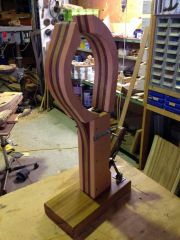-
Posts
1,038 -
Joined
-
Last visited
Content Type
Profiles
Forums
Events
Blogs
Gallery
Everything posted by Thor
-
Purse pattern for newish leather worker
Thor replied to lorraine g's topic in Patterns and Templates
Yes, it looks like you added a zero too many all around. I always use a graphic program and size it to my needs. -
Purse pattern for newish leather worker
Thor replied to lorraine g's topic in Patterns and Templates
Sandra, are you sure about the measurements? -
Johanna, is there a chance to have a toggle option for the sidebar (status updates, recent topics...)?
-
Purse pattern for newish leather worker
Thor replied to lorraine g's topic in Patterns and Templates
Try any of these links: https://www.pinterest.com/pin/557461260106972363/ https://www.pinterest.com/pin/557461260105912895/ https://www.pinterest.com/pin/557461260106033907/ They are all dealing with that style. I believe I'm having even more of those on my Pinterest boards. -
-
Congrats and thank you Johanna and gang, this is working much smoother than the old software. I'm liking it a lot and I hope others enjoy and acknowledge the work you did put into this. Of course there are things one has to get used to again, but this software seems to be much better. Thumbs up!
-
Just to confuse you a bit more... Doeskin can be made from the hide of the female deer as Birdman states, but can also be from a lamb or sheep and is mostly used for gloves, but the term can also stand for a heavy smooth satin-weave or twill-weave cloth.
-
Haven't had any good and remaining results burnishing goat skin. I ended up using a soldering iron and if that's not an option I'm folding it inwards.
-
Who recommended rubbing with alcohol? Oiling it prior to dyeing is something that is recommended at times. I never clean leather with alcohol. If at all I use oxalic acid. Anyhow you will have to use darker dye now as you can't get this out again. I'd use dark brown around the flowers and leaves, making it a two tone color and also promoting your tooling better. Besides, nice job on the tooling.
-
Belt For A Client
Thor replied to venator's topic in Purses, Wallets, Belts and Miscellaneous Pocket Items
I really like your logo. -
Pattern Needed: Ben Cartwright (Bonanza) Vest
Thor replied to Dwight's topic in Patterns and Templates
LOL you're right and I never paid attention to that either, but than again this was the time when they all had endless ammunition in their volts ;-) If you want to make the holster as well you might like to have this link as well https://www.liveauctioneers.com/item/6314459_lorne-greene-gunbeltquickdraw-rig-from-bonanza If I can figure it out how it's been done correctly - the collar - I'll let you know. -
Pattern Needed: Ben Cartwright (Bonanza) Vest
Thor replied to Dwight's topic in Patterns and Templates
Had to search pretty hard to find it, cause the collar is usually covered by the collar of his shirt, but I'm positive that the collar goes all around now. Check these pictures please: https://autrylibraries.files.wordpress.com/2011/07/dortort-greene-88-1.jpg http://media.gettyimages.com/photos/the-colonel-episode-15-pictured-john-larkin-as-col-frank-medford-as-picture-id145136457 They are too large to post them here. Obviously the collar is part of the left and right as well as of the back element and then stitched together. That must be the reason why it looks like it's tucked in at the shoulders. If you manage to get it done I'd like to see the result -
I do have them and I'm not too happy with em. The reason being is that the aren't polished. Once they are, they are okay.
-
Pattern Needed: Ben Cartwright (Bonanza) Vest
Thor replied to Dwight's topic in Patterns and Templates
Dwight, I might be wrong, but it looks to me like a standard straight cut vest with a collar added to it. Modifying the one in Tandy's vest pattern pack might do the trick. Along with the pics on this page http://www.leather-shop.biz/mens-leather-vests/mens-leather-vest-bonanza-style-mlv75/ you should be able to copy it. If you need the vest pattern, send me a PM. -
My Blue Daily Bag
Thor replied to olenawills's topic in Purses, Wallets, Belts and Miscellaneous Pocket Items
Very nicely done! -
What you can do is either to just convert the jpg to a vector file yourself with a software like inkscape or go here http://seeklogo.com/tag.html?q=police and see if one of them fits your bill. If it doesn't follow this search thru https://www.google.de/search?q=police+badge+vector+free&num=50&newwindow=1&client=ubuntu&espv=2&source=lnms&tbm=isch&sa=X&ved=0ahUKEwisxO3o_MHLAhWodpoKHQqABM8Q_AUIBygB&biw=1229&bih=802
-
Review the pics here. This should help you. https://www.pinterest.com/riding1493/archery/
-
Re-Lining A Louis Vuitton Bucket Bag
Thor replied to YinTx's topic in Purses, Wallets, Belts and Miscellaneous Pocket Items
Looking very nice Yin. Never done that before, so here's a question for you. Is that extra step of stitching the liner actually needed or wouldn't it just do if it would be stitched along with the edge?- 6 replies
-
- louis vuitton
- relining purse
-
(and 2 more)
Tagged with:
-
The CEO was replaced recently. I would assume it was done for a reason.
-
I Need Pattern And Book Suggestions Please
Thor replied to Spaceblues's topic in Patterns and Templates
If you are interested in a good book on Sheridan tooling etc. go here https://www.facebook.com/Bob-Park-Custom-Leather-131291347030087/ Bob's book has quite some insight on designing. Not on the actual tooling. A good book on tooling is Sheridan Style Carving by Bill Gardner. -
Oops sorry http://pin.it/qhUsnAV
-
Bob, I'm not sure if this is what you have in mind, but I came across this picture and thought it might work. Along with dirkba's tutorial it may work.
-
It also depends on the leather being used. I've seen it from 1/8 to 1/4". And yes there are a few in the pattern section.
-
I must have missed the part about the antique gel. Seconded what he wrote. The gel isn't waterproof at all.



